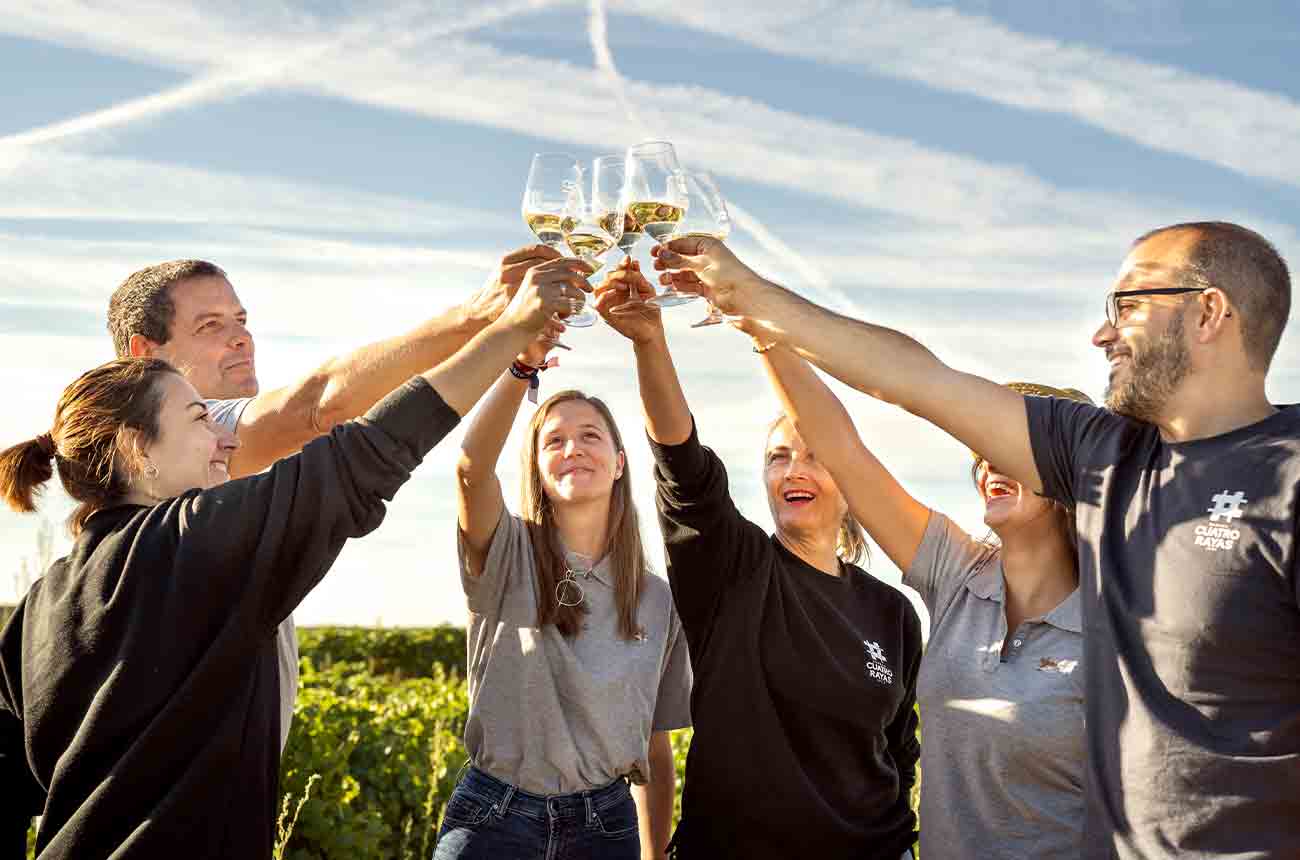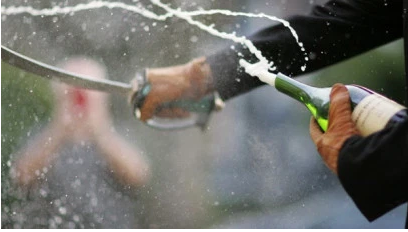Bodega Cuatro Rayas – Sustainably championing DO Rueda

Bodega Cooperativa de La Seca was founded in 1935, at the dawn of the Spanish Civil War, as winegrowing families from the small town of La Seca, in northwest Spain, sought stability amidst political uncertainty. It has since been renamed Bodega Cuatro Rayas, playing a key role in the economic and social cohesion of the DO Rueda throughout a turbulent century.
The winery remains one of the DO’s most important stakeholders, managing a total of 2,400ha from 300 members. Bodega Cuatro Rayas counts some of the region’s oldest vineyards – including ungrafted 120-year-old plots – among its members’ holdings. Its viticultural and winemaking programme, focused on the local Verdejo grape, yields a diverse range of wines. From approachable everyday drinkers to exclusive single-vineyard bottlings, Bodega Cuatro Rayas’ bottlings express the character of Rueda’s terroirs and the passion of those who work its land.
Elena Martin Oyagüe, winemaker and technical director at Bodega Cuatro Rayas
Knowledge and precision
Elena Martin Oyagüe, who joined Bodega Cuatro Rayas in 1997 and has been its technical director since 2017, highlights the increasing importance of vineyard and grape selection as the basis of a greater focus on quality across the winery’s range. ‘We are placing more and more emphasis on the classification and categorisation of vineyards and grapes,’ she explains. ‘This will allow us to better understand the nature and potential of each plot and develop wines that express the character and versatility of Verdejo.’
Bodega Cuatro Rayas has partnered with the University of León as part of a research project on the genetic diversity of indigenous grape varieties and the ageing capacity of the sometimes underestimated Verdejo. ‘We want to increase the expressiveness of our higher end wines while raising awareness of Verdejo’s true potential – especially the fruit hailing from our oldest, low-yielding vineyards,’ explains Martin Oyagüe. These bush-trained, hand harvested plots provide the raw material for Bodega Cuatro Rayas’ top bottlings: Bodega Cuatro Rayas Viñedos Centenarios, Cuarenta Vendimias and Amador Diez (a tribute to the cooperative’s president from 1975 to 1996).
The winery maintains this level of focus without losing sight of the importance of the higher-volume, more commercial lines it produces, which allow the cooperative to introduce a wider audience to Rueda and Verdejo. The company has household status in Spain – especially when it comes to Verdejo wines – and has a prominent presence in more than 50 export markets, including China, US, Germany, UK, Mexico and the Netherlands.

Green & Social
Crucial steps have been taken in the last couple of decades to cement the cooperative’s environmental and social strategy, with a strong focus on terroir awareness, smart use of resources and member engagement. Bodega Cuatro Rayas has developed its own encompassing sustainability programme, ‘Green & Social’, which affirms an ongoing commitment to protecting both the environment and local communities. Economic transparency, governance best-practice, quality, innovation, and a fair and close engagement with members are considered alongside the reduction of carbon emissions and the development of smart, precision viticultural practices.
Following Rueda’s plantation boom in the 1990s, it soon became clear for the Bodega Cuatro Rayas team that empowering growers to understand the specific needs of their distinct vineyards was essential if the desired quality and consistency were to be achieved. The cooperative provides ongoing training, so that its members can tailor their practices to the unique profile of each site. Raising awareness of the importance of smart use of water resources has been prioritised in the face of climate change, and of multiple vintages incurring severe drought.

When asked about what future challenges lie ahead, Martin Oyagüe points to the logistical limitations imposed by extreme weather conditions as the most complex. ‘Harvest is now happening earlier and we need to harvest quicker to retain freshness and finesse. This, while trying to implement a stricter selection programme. Not easy when managing 2,400ha of vines,’ explains the oenologist. But having weathered so many economic and political storms during its 90 years of history, Bodega Cuatro Rayas is equipped with the perseverance of 300 members working together to keep producing the very best Verdejos.
Three expressions of Verdejo from Bodega Cuatro Rayas
Cuatro Rayas Vendimia Nocturna, DO Rueda 2023
100{83994d7454f8ce68441ea8152244c292227c3db19076e7622c8f5ff92141c35a} Verdejo
The cooperative’s signature wine, made with fruit from the eponymous Pago de las Cuatro Rayas, harvested mechanically by night. There’s a tropical richness to the fruit profile with notes of passionfruit, melon and pink grapefruit mingling with ripe orchard fruit. There’s a subtle, pleasant richness to the mid-palate offset by the zesty pull of lime zest and gooseberry. Alc 12.5{83994d7454f8ce68441ea8152244c292227c3db19076e7622c8f5ff92141c35a}
90 points
Cuatro Rayas Viñedos Centenarios, DO Rueda 2023
100{83994d7454f8ce68441ea8152244c292227c3db19076e7622c8f5ff92141c35a} Verdejo
Partially fermented in barrique and aged on the lees for five months, this is an elegant and characterful Verdejo with subtle toasty notes over a rich core of white grapefruit, peach and green apple. Herbal nuances of wild fennel and oregano give it a very Mediterranean character. Zesty acid and mineral backbone give it focus and depth. An expressive Verdejo from 100-year-old vineyards planted on sandy soils, in and around Segovia. Great food pairing potential. Enjoy with grilled tiger prawns, seared scallops or salted cod. Alc 13{83994d7454f8ce68441ea8152244c292227c3db19076e7622c8f5ff92141c35a}
91 points
Amador Diez Gran Vino de Rueda, DO Rueda 2020
100{83994d7454f8ce68441ea8152244c292227c3db19076e7622c8f5ff92141c35a} Verdejo
A serious and ageworthy Verdejo, fermented and aged for seven months, on the lees, in first-use barriques with weekly batônnage. The grapes are gently, whole-bunch pressed and only the first press is used. After the initial stage in barriques, the wine spends five months in foudres and one year in bottle before release to market.
Complex aromatic profile with roasted almonds, yellow apple, poached greengage, beeswax and honey-glazed almonds. This richness is offset by a firm acid backbone. Long finish, with lingering notes of roasted almonds and apple peel. A wine to enjoy with food; roasted chicken and medium-cured cheeses would be a perfect match. Alc 13{83994d7454f8ce68441ea8152244c292227c3db19076e7622c8f5ff92141c35a}
93 points
Discover more about Bodega Cuatro Rayas
Connect on
Facebook | Instagram | Twitter | YouTube



